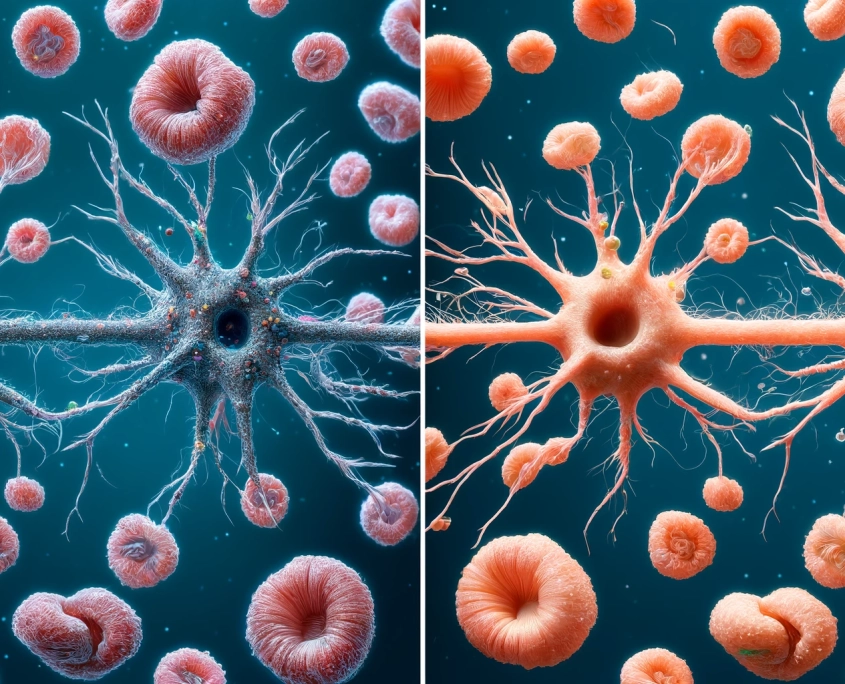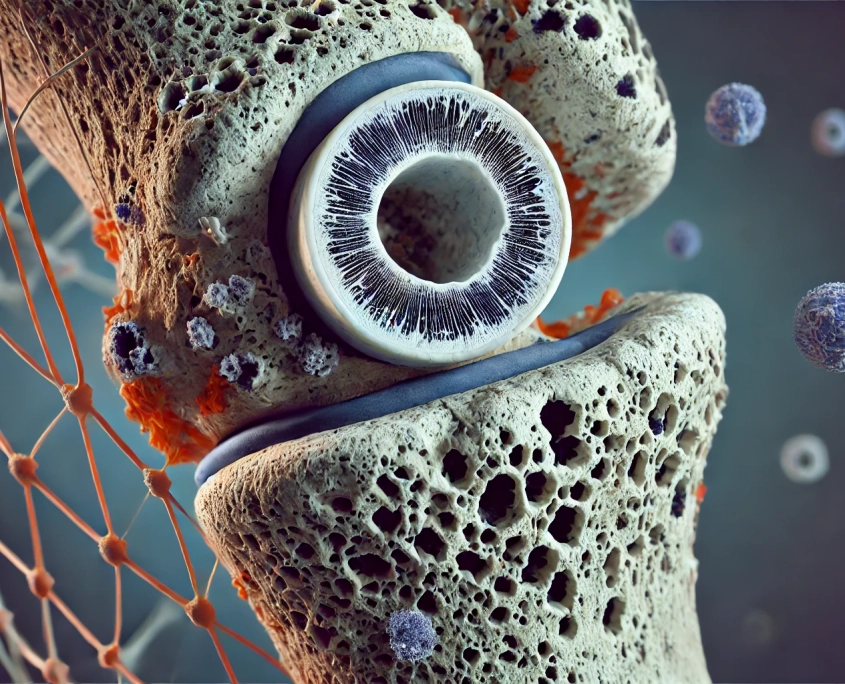
The cellular environment is a dynamic space where countless biochemical processes occur, all of which are essential for the survival, repair, and regeneration of tissue. Among the various components that play a crucial role in maintaining cellular function, cytosol extracts have garnered attention for their potential to support cellular healing and regeneration. Cytosol extracts, derived from the cytoplasm of animal tissues, contain enzymes, nutrients, and signaling molecules that can help promote tissue repair in humans. This paper will explore the role of cytosol extracts in cellular repair and their potential applications in modern medicine, with a focus on the pioneering work of Dr. Royal Lee, who laid the foundation for their therapeutic use.
Dr. Royal Lee: A Pioneer in Cytosol Extract Development
Dr. Royal Lee, a visionary in the field of nutrition and cellular therapy, was among the first to advocate for the use of cytosol extracts in promoting cellular repair. His innovative approach was based on the belief that specific cellular components could be harvested from animal tissues to aid the healing and regeneration of corresponding tissues in humans. Through his extensive research, Dr. Lee developed cytosol extracts that targeted various organs and systems, including extracts from liver, heart, adrenal glands, and other tissues.
Lee’s philosophy was rooted in the idea of bioavailability and the natural synergy of nutrients. He believed that the complex, whole-food nutrients found in cytosol extracts were far superior to synthetic, isolated nutrients. This led him to create supplements that were minimally processed, ensuring that the active components remained as close to their natural state as possible. He understood that the delicate balance of enzymes, peptides, and cofactors found in cytosol extracts was essential for their efficacy in supporting tissue repair.
His most notable innovation in this area was the development of glandular cytosol extracts, which aimed to provide the body with essential nutrients and components needed for the repair of specific tissues. For example, liver extracts were used to promote hepatic repair, while heart extracts were believed to support cardiovascular health. Dr. Lee’s cytosol extracts represented a breakthrough in nutritional therapies, offering a targeted approach to cellular healing.
Although his work was met with skepticism during his lifetime, Dr. Lee’s contributions have since gained recognition for their pioneering approach to regenerative medicine. His innovations paved the way for modern developments in cytosol-based therapies, and his commitment to whole food nutrition remains a cornerstone in the field of integrative medicine today.
Mechanisms of Cellular Repair and Regeneration
At the cellular level, the processes of repair and regeneration are critical to maintaining tissue health and function. Cells continually experience damage due to environmental stressors, oxidative processes, and the natural aging cycle. In response, the body has evolved sophisticated mechanisms to repair damaged cells and regenerate tissues. Cytosol extracts play a potentially vital role in these processes by providing cells with essential bioactive molecules that facilitate repair, protect against further damage, and promote regeneration.
1. Enzymes and Growth Factors
Cytosol extracts contain a variety of enzymes and growth factors that are crucial for cellular repair. Enzymes like proteases, lipases, and nucleases assist in breaking down damaged cellular components, while growth factors such as epidermal growth factor (EGF) and insulin-like growth factor (IGF) are key players in stimulating cell division and tissue regeneration. These components, found naturally in cytosol extracts, help expedite the process of healing by initiating and regulating cellular activities needed for repair.
Growth factors in cytosol extracts are particularly significant in regenerating tissues after injury. For instance, EGF helps stimulate the proliferation of epithelial cells, which are vital for wound healing and tissue regeneration. Similarly, IGF is involved in promoting muscle regeneration, making cytosol extracts beneficial for tissues that require rapid repair, such as muscle and skin.
2. Mitochondrial Support
Mitochondria, the powerhouses of the cell, are essential for energy production and cellular function. Cellular repair is an energy-intensive process, requiring optimal mitochondrial function to facilitate protein synthesis, cell division, and the removal of damaged cellular components. Cytosol extracts can support mitochondrial health by providing co-factors like NAD+ and essential nutrients that enhance energy production and metabolic processes.
Research has shown that cytosol extracts derived from metabolically active tissues, such as liver and heart, contain high concentrations of molecules that support mitochondrial function. By improving mitochondrial efficiency, these extracts help cells recover faster from damage and maintain their ability to regenerate new tissue.
3. Cellular Signaling and Communication
Effective cellular repair requires precise communication between cells. Cytosol extracts are rich in signaling molecules that modulate the immune response and coordinate tissue repair efforts. These signaling molecules can enhance intercellular communication, facilitating a more synchronized and efficient healing process.
For example, cytokines present in cytosol extracts help regulate the immune response during tissue damage, preventing excessive inflammation that can hinder repair. This balanced modulation ensures that the body’s natural repair mechanisms are optimized without causing collateral damage to healthy tissues. Furthermore, cytosol extracts can influence the activation of signaling pathways like mTOR and AMPK, which are involved in cellular growth and metabolism.
4. Protein Synthesis and Tissue Regeneration
Protein synthesis is a cornerstone of cellular repair and regeneration. After tissue damage, the body must synthesize new proteins to replace damaged or lost components. Cytosol extracts provide a rich source of amino acids, peptides, and other protein precursors that are essential for this process.
Cytosol extracts derived from tissues such as liver and kidneys contain specific proteins that act as building blocks for cellular regeneration. By supplying the necessary materials for protein synthesis, these extracts accelerate the repair of damaged tissues, promoting faster recovery and enhanced regenerative potential. This makes cytosol extracts especially valuable in conditions involving tissue degeneration, chronic injuries, or aging-related decline.
Scientific Evidence and Studies
The therapeutic potential of cytosol extracts has been supported by a growing body of scientific research, which demonstrates their effectiveness in promoting cellular repair and tissue regeneration. Both in vitro (laboratory) studies and in vivo (animal and human) clinical trials have provided valuable insights into the mechanisms by which cytosol extracts contribute to healing processes and their possible applications in modern medicine.
1. In Vitro Studies: Cytosol Extracts in Cellular Models
Research conducted in cell cultures has provided compelling evidence that cytosol extracts can enhance cellular repair mechanisms. In these studies, cells exposed to cytosol extracts from animal tissues such as liver, heart, or kidney showed accelerated recovery after damage. For example, cytosol extracts were found to stimulate protein synthesis in fibroblast cells, which are essential for wound healing and tissue regeneration. The extracts also increased the expression of key proteins involved in cellular metabolism and repair, such as collagen and elastin, supporting the structural integrity of tissues.
Furthermore, studies on muscle cells have shown that cytosol extracts from skeletal muscle tissues improve the recovery and regeneration of myofibers after injury. These findings highlight the potential of cytosol extracts to aid in muscle repair and regeneration, which is particularly relevant in the context of athletic recovery, injury rehabilitation, and degenerative muscle diseases.
2. In Vivo Studies: Animal Models and Clinical Trials
Animal studies have played a crucial role in demonstrating the regenerative capacity of cytosol extracts. In one study, liver cytosol extracts were used to treat animals with chemically induced liver damage. The treated animals showed improved liver function and faster regeneration of hepatocytes (liver cells) compared to the control group. This suggests that cytosol extracts from specific organs may contain the biochemical tools needed to support the regeneration of damaged tissues.
Similarly, heart cytosol extracts have been studied for their role in myocardial repair after cardiac injury. In animal models of myocardial infarction (heart attack), the administration of heart-derived cytosol extracts promoted the regeneration of cardiac muscle cells and improved heart function. These results are promising for potential applications in cardiovascular repair therapies, especially for individuals recovering from heart damage.
Human clinical trials, though still in early stages, have begun to explore the efficacy of cytosol extracts in treating degenerative conditions and enhancing recovery. For example, studies involving patients with chronic skin wounds have shown that topical application of cytosol extracts derived from epithelial cells improved wound healing, reduced scarring, and increased the rate of tissue regeneration.
3. Cellular and Molecular Mechanisms: Pathway Activation
Several studies have explored the molecular mechanisms through which cytosol extracts facilitate cellular repair. A key finding from these studies is the ability of cytosol extracts to activate pathways such as the mammalian target of rapamycin (mTOR) and AMP-activated protein kinase (AMPK) pathways. These signaling pathways are central to cellular growth, metabolism, and autophagy (the process by which cells remove damaged components).
Activation of the mTOR pathway by cytosol extracts leads to increased cell growth and protein synthesis, crucial for tissue repair and regeneration. Conversely, activation of the AMPK pathway promotes cellular energy balance, supporting recovery in cells that have been stressed or damaged. This dual modulation of key metabolic pathways by cytosol extracts is one of the reasons for their effectiveness in cellular healing.
4. Therapeutic Potential in Aging and Degenerative Conditions
Cytosol extracts have also been investigated for their potential to mitigate the effects of aging and degenerative diseases. Aging is associated with a decline in cellular repair capacity, leading to tissue degeneration, loss of function, and an increased susceptibility to injury. Cytosol extracts, by providing the body with bioactive molecules that promote cellular repair, have shown promise in slowing the effects of aging at the cellular level.
For instance, studies have explored the use of cytosol extracts in neurodegenerative diseases, such as Alzheimer’s and Parkinson’s disease. Cytosol extracts from neural tissues were found to improve neuronal function and reduce the buildup of toxic proteins in animal models of these conditions. Although human studies are still limited, these findings suggest that cytosol extracts could play a role in therapeutic interventions for age-related degenerative diseases.
Therapeutic Implications in Modern Medicine
The potential applications of cytosol extracts in modern medicine are vast, spanning from wound healing and regenerative therapies to treating degenerative diseases and mitigating the effects of aging. As the scientific understanding of cytosol extracts continues to grow, their therapeutic implications become increasingly relevant in clinical settings. Below, we explore several promising areas where cytosol extracts could play a pivotal role in advancing medical treatments.
1. Wound Healing and Tissue Repair
Cytosol extracts have shown great promise in accelerating wound healing by supporting the natural repair processes of the body. Their ability to stimulate protein synthesis, promote collagen production, and enhance cell proliferation makes them particularly effective in treating both acute and chronic wounds. In clinical settings, cytosol extracts could be applied topically in the form of creams, gels, or dressings to promote faster recovery and reduce scarring.
Moreover, cytosol extracts may be useful in treating more complex injuries, such as burns or post-surgical wounds, where traditional treatments are often inadequate. By promoting regeneration at the cellular level, cytosol extracts offer a novel approach to tissue repair that could significantly improve patient outcomes.
2. Regenerative Medicine and Organ Repair
One of the most exciting therapeutic applications of cytosol extracts lies in the field of regenerative medicine. By providing the body with bioactive molecules that facilitate the repair of specific tissues, cytosol extracts can help regenerate damaged organs, such as the liver, heart, and kidneys. This is especially relevant in the treatment of chronic conditions like liver cirrhosis, myocardial infarction, and chronic kidney disease, where the body’s ability to repair itself is compromised.
For instance, liver-derived cytosol extracts have been studied for their potential to support liver regeneration in patients with liver disease. Similarly, heart cytosol extracts may assist in regenerating heart muscle following a heart attack, helping to restore cardiac function and prevent further damage. In the future, cytosol-based therapies could offer an alternative to more invasive procedures, such as organ transplants, by enhancing the body’s own regenerative capacity.
3. Degenerative Diseases and Aging
As the population ages, the incidence of degenerative diseases, such as Alzheimer’s, Parkinson’s, and osteoarthritis, is on the rise. These conditions are often characterized by the progressive loss of tissue function and the inability of cells to repair themselves effectively. Cytosol extracts could provide a novel therapeutic approach by supplying damaged cells with the necessary components for regeneration and repair.
In neurodegenerative diseases like Alzheimer’s and Parkinson’s, cytosol extracts derived from neural tissues have shown promise in preclinical studies for supporting neuronal repair, improving cognitive function, and reducing the accumulation of toxic proteins that contribute to disease progression. While more research is needed, these early findings suggest that cytosol extracts could be an integral part of future therapies aimed at slowing or reversing the effects of degenerative diseases.
4. Anti-Aging and Skin Health
The skin, as the body’s largest organ, is highly susceptible to aging and environmental damage. Cytosol extracts, particularly those derived from skin or epithelial tissues, can play a significant role in anti-aging treatments by promoting collagen production, enhancing skin elasticity, and accelerating the repair of damaged skin cells. This has led to the development of cytosol extract-based skincare products that aim to rejuvenate the skin and reduce the appearance of wrinkles and fine lines.
In addition to their cosmetic applications, cytosol extracts could be used to treat skin conditions such as psoriasis, eczema, and chronic wounds. By improving the skin’s natural regenerative processes, these extracts offer a promising alternative to conventional treatments that often rely on synthetic drugs or invasive procedures.
5. Potential for Personalized Medicine
With advances in biotechnology, the use of cytosol extracts could be tailored to the specific needs of individual patients. This personalized approach would involve selecting cytosol extracts derived from particular tissues based on a patient’s condition, genetic makeup, and health profile. For example, patients recovering from liver disease could receive liver-specific cytosol extracts, while those with muscle injuries could benefit from muscle-derived extracts.
The ability to customize cytosol-based therapies to target specific tissues opens the door to a more precise and effective form of treatment. Personalized cytosol therapies could become a key component of future regenerative medicine, offering patients tailored solutions that optimize healing and recovery.
Cytosol extracts represent an exciting frontier in regenerative medicine and cellular healing. By harnessing the bioactive components found within the cytoplasm of animal tissues, cytosol extracts provide essential nutrients, enzymes, and growth factors that promote cellular repair and regeneration. The pioneering work of Dr. Royal Lee has laid the groundwork for their therapeutic application, offering a foundation for the development of novel treatments aimed at enhancing the body’s natural healing processes.
As scientific research continues to uncover the mechanisms through which cytosol extracts facilitate tissue repair, their potential applications in modern medicine become increasingly clear. From accelerating wound healing to supporting organ repair and combating degenerative diseases, cytosol extracts hold promise as a valuable tool in promoting long-term health and recovery. Their future in personalized and regenerative therapies could provide more targeted and effective treatments, paving the way for breakthroughs in medicine that harness the body’s own regenerative capacities.
As we move forward, further research and clinical trials will be critical in validating the efficacy of cytosol extracts across various medical conditions. However, the current body of evidence suggests that cytosol-based therapies could soon become an integral part of modern medicine, offering patients new pathways to recovery and cellular rejuvenation.










